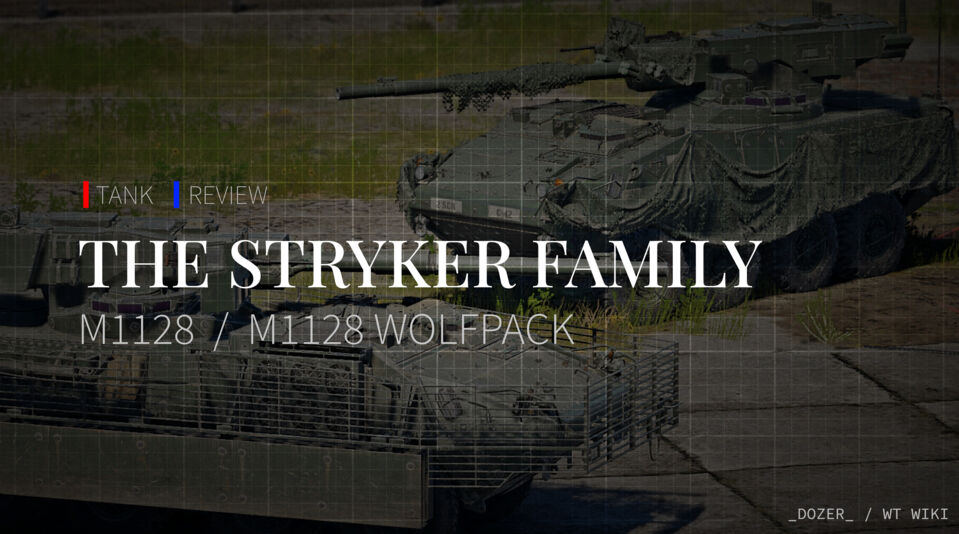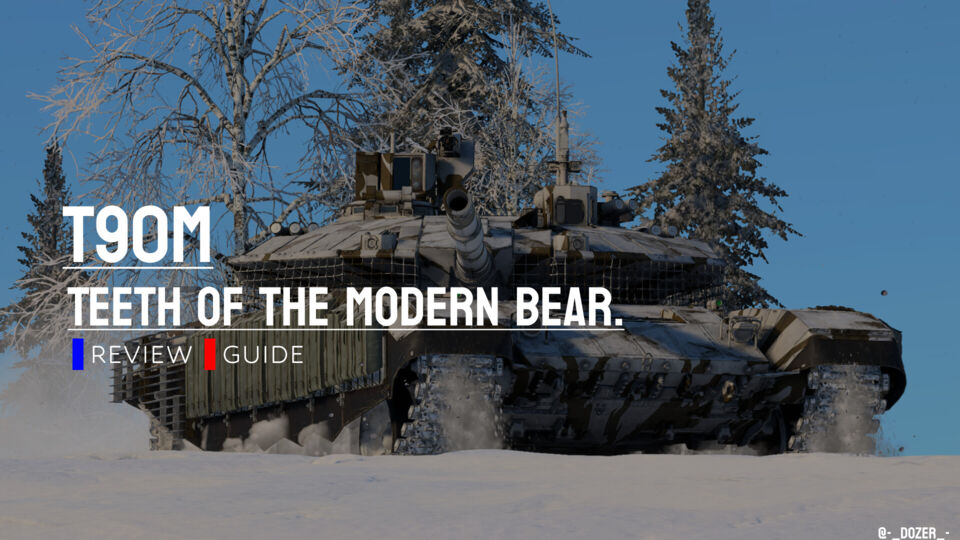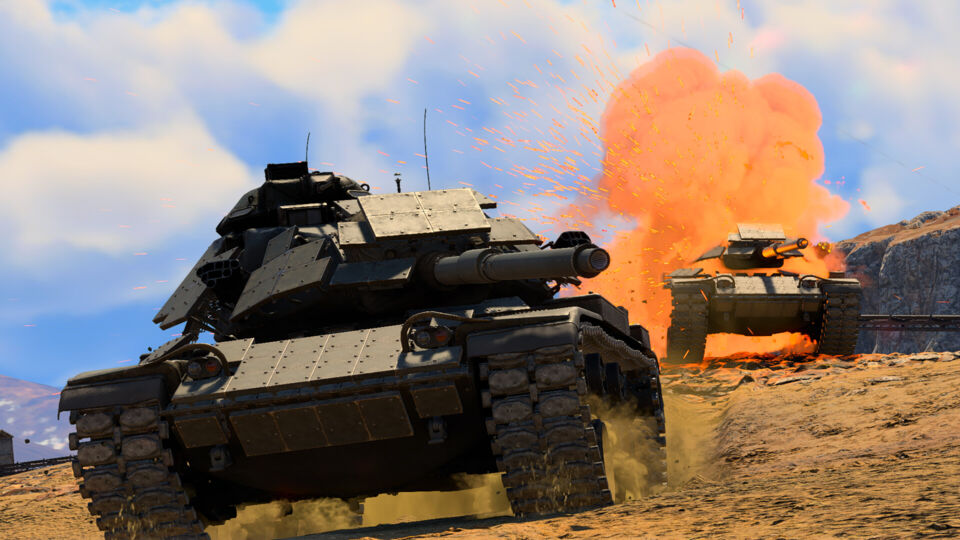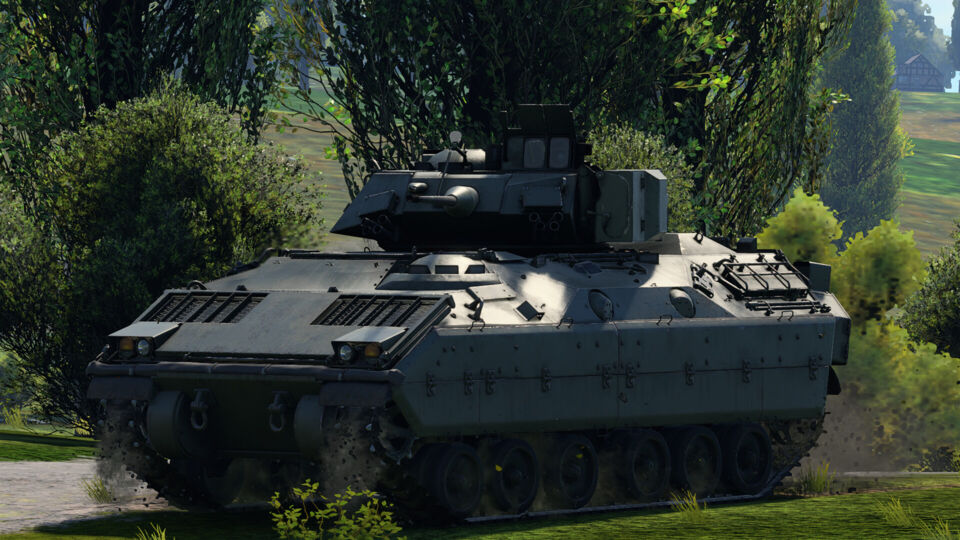The M1128 Stryker is the heavy hitter of the Stryker family, built to take on enemy tanks from long range effectively. Built on an 8×8 wheeled chassis, it trades heavy protection for high mobility and long‑range firepower. An unmanned 105 mm turret, complete with two‑plane stabilisation and a 8‑round autoloader, lets the M1128 engage targets on the fly both effectively and safely. The Wolfpack premium variant shares identical performance to the tech tree Stryker, but swaps the add-on slat armour for a camouflage net and premium economic bonuses.
Emerging from the T‑72 lineage, the T‑90A refines Cold War resilience with early‑2000s tech upgrades. Outfitted with Kontakt‑5 ERA and a composite armor suite, it maintains a low silhouette while boasting a robust defensive profile against both kinetic and chemical rounds. At its core sits the 125 mm 2A46M‑5 cannon autoloaded and stabilized, capable of launching a wide range of ammunition, from standard APFSDS to tandem‑warhead ATGMs. Its most distinct feature, however, is the Shtora-1 electro‑optical protection system — it's an "unblinking hunter", thanks to its ever-watchful "eyes".
Emerging from the T‑72/T‑90 lineage, the T‑90M “Proryv” blends proven Soviet design with targeted modernizations. Relikt ERA and composite modules reinforce its low‑profile turret and sloped glacis, reducing incoming damage. At its heart sits the 125 mm 2A46M‑5 cannon with an autoloader, capable of launching APFSDS, HEATFS, HE, or tandem‑warhead ATGMs offering adaptable firepower at all ranges. Though its –6° gun depression and 4 km/h reverse speed limit certain hull‑down and withdrawal maneuvers, the T‑90M excels when used to dictate engagements from hull‑down positions, supporting advances and punishing overextended foes.
The 120S is a modern upgrade built on a M60 hull with a M1A1 turret, marrying legacy design with contemporary firepower. With a powerful 120 mm M256 cannon and enhanced optics, it offers fresh tactical opportunities while retaining the familiar playstyle of its predecessor. Although the hull’s protection and mobility have limitations compared to fully modern designs, the 120S opens up new strategic possibilities on the battlefield.
The M60A3 TTS (Tank Thermal Sight) is the final evolution of the legendary M60 Patton series. Equipped with advanced optics, improved firepower, and enhanced survivability features, the M60A3 TTS remains a formidable force on the battlefield. While it may lack the speed and cutting-edge technology of modern MBTs, its robust armor and powerful 105mm cannon ensure it can still hold the line against contemporary threats.
The M3 Bradley is a testament to American battlefield versatility, blending speed, firepower, and reconnaissance into a single armored platform. Developed alongside its M2 Bradley Infantry Fighting Vehicle (IFV) counterpart, the M3 Cavalry Fighting Vehicle (CFV) was tailored for both scouting and tank-killing missions, offering a balance of mobility, firepower, and survivability. Unlike main battle tanks, the M3 Bradley relies on hit-and-run tactics, ambushes, and rapid relocations to stay ahead of the enemy. Armed with a 25mm M242 Bushmaster autocannon, BGM-71 TOW anti-tank guided missiles, and a 7.62mm M240 machine gun, the M3 excels at engaging a wide range of targets. However, its armor protection is limited, requiring careful positioning and tactical awareness to survive on the battlefield.
The XM803 stands as a daring experiment in American tank design, conceived from the ambitious MBT-70 program. Initially envisioned as a next-generation main battle tank to replace the aging M60 family, the XM803 was engineered to combine overwhelming firepower with exceptional mobility. Outfitted with a cutting-edge 152 mm XM150E6 gun/launcher, advanced targeting systems, and a two-plane gun stabilizer paired with an autoloader, it promised to redefine battlefield engagement. Yet, in its quest to balance performance and cost, the XM803 sacrificed armor protection and crew survivability making it a high risk, high reward vehicle that rewards skilled, hit-and-run tactics with its incredible mobility and firepower.
The M60A1 (AOS) represents an important evolutionary step in the American main battle tank lineage. Introduced as an improvement over the standard M60, the AOS (Add-On Stabilization) variant features a two-plane gun stabilizer, significantly enhancing its ability to fire accurately on the move. While it retains the powerful 105 mm M68 cannon of its predecessor, it also introduces an improved turret design with better-angled armor compared to the hemispherical turret of the standard M60. However, its large silhouette and underwhelming mobility make it vulnerable in fast-paced engagements. In the right hands, though, it can be a highly effective frontline vehicle.
The T95E1 represents a bold step forward in American tank design. Developed during the early years of the Cold War, the T95E1 was engineered to tackle the challenges posed by emerging armored threats. With a focus on advanced firepower, this experimental tank was designed to push the boundaries of what was possible in future armored warfare. In-game, the T95E1 has a 90mm smoothbore gun capable of firing APFSDS with excellent ballistics and angled penetration. Though the T95E1 has less impressive mobility and even worse armor, good positioning and capitalizing on the firepower can make the most out of this prototype tank.








